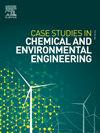Textile effluent treatment in a pilot-scale UASB bioreactor followed by biofilter and aerobic processes
Q1 Environmental Science
Case Studies in Chemical and Environmental Engineering
Pub Date : 2024-12-18
DOI:10.1016/j.cscee.2024.101075
引用次数: 0
Abstract
This paper presents an overview of an industrial textile effluent treatment for 12 years of 24-h operating conditions in the UASB (up-flow anaerobic sludge blanket) bioreactor, followed by a biofilter and aerobic processes. The textile effluent pollution parameters, such as pH, temperature, dissolved oxygen (DO), chemical oxygen demand (COD), total suspended solids (TSS), color, and total dissolved solids (TDS), were tested at 3-month intervals. The raw textile wastewater consisted of dark in color (405 ± 15 Pt–Co scale), high pH (12 ± 2.0), COD (2016 ± 1125 mg L−1), temperature (65 ± 5 °C), TSS (250 ± 125 mg L−1) and TDS (9000 ± 1200 mg L−1). The UASB bioreactor was more effective for removing 55.0% of COD, 84.0% of TSS, and 80.7% of color. The biofilter removed TDS (39.0%) and increased the DO level effectively, while the aerobic process was found less effective in removing color from the textile effluent. The combination of the UASB, biofilter, and aerobic processes effectively removed 93.05% of COD and 86.41% of color at the maximum organic loading rate (OLR) with 52.64 hrs of hydraulic retention time (HRT). Among the other pollution parameters, the combined system had an overall removal efficiency of 96.0% of TSS and 77.8% of TDS. This system also raised the DO level from 0.0 to 6.04 ± 1.02 mg L−1, and the pH of the final treated effluent was neutral. This study concludes that the combined process is a workable option for treating textile effluent, which fulfills the national standard of effluent quality for discharging to the environment.

在中试规模的UASB生物反应器中处理纺织品废水,随后采用生物过滤器和好氧工艺
本文概述了在UASB(上流式厌氧污泥毯)生物反应器中处理工业纺织废水12年的24小时操作条件,然后是生物过滤器和好氧过程。每隔3个月对纺织废水的pH、温度、溶解氧(DO)、化学需氧量(COD)、总悬浮物(TSS)、颜色和总溶解固体(TDS)等污染参数进行检测。原纺废水颜色较深(Pt-Co标度为405±15),pH值为12±2.0,COD为2016±1125 mg L−1,温度为65±5℃,TSS为250±125 mg L−1,TDS为9000±1200 mg L−1。UASB生物反应器的COD去除率为55.0%,TSS去除率为84.0%,色度去除率为80.7%。生物滤池对TDS的去除率为39.0%,对DO的去除率为39.0%,而好氧工艺对纺织废水的去色效果较差。UASB +生物滤池+好氧工艺在最大有机负载率(OLR)、水力停留时间(HRT)为52.64 h的情况下,可有效去除93.05%的COD和86.41%的颜色。在其他污染参数中,联合系统对TSS的总去除率为96.0%,对TDS的总去除率为77.8%。该系统还将DO水平从0.0提高到6.04±1.02 mg L−1,最终处理出水pH为中性。研究结果表明,采用复合工艺处理纺织废水是一种可行的方案,并能满足国家对环境排放的出水质量标准。
本文章由计算机程序翻译,如有差异,请以英文原文为准。
求助全文
约1分钟内获得全文
求助全文
来源期刊

Case Studies in Chemical and Environmental Engineering
Engineering-Engineering (miscellaneous)
CiteScore
9.20
自引率
0.00%
发文量
103
审稿时长
40 days
 求助内容:
求助内容: 应助结果提醒方式:
应助结果提醒方式:


